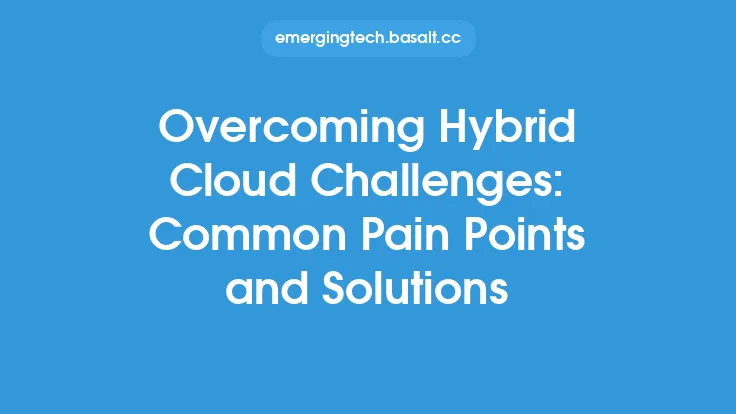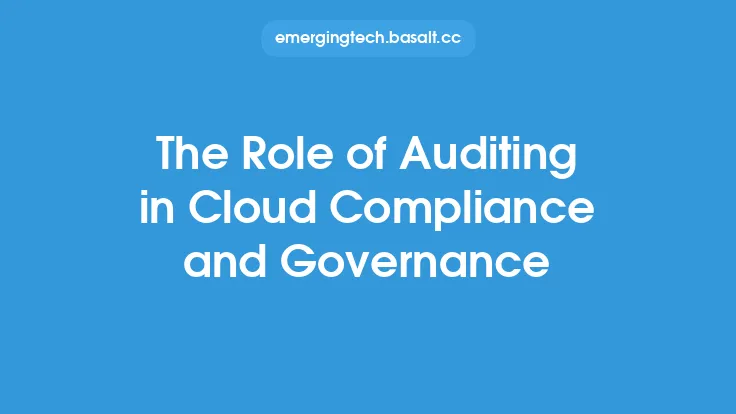As organizations continue to migrate their infrastructure and applications to the cloud, the need for effective cloud governance has become increasingly important. Cloud governance refers to the set of policies, procedures, and standards that ensure an organization's cloud-based resources are used in a secure, compliant, and efficient manner. Implementing cloud governance can be a complex and challenging task, but it also presents numerous opportunities for organizations to improve their overall IT operations and achieve their business objectives.
Introduction to Cloud Governance
Cloud governance is a critical component of an organization's overall IT governance framework. It involves defining and implementing policies, procedures, and standards for the use of cloud-based resources, including infrastructure, platforms, and applications. Effective cloud governance ensures that an organization's cloud-based resources are used in a way that aligns with its overall business strategy and objectives, while also ensuring compliance with relevant laws, regulations, and industry standards. Cloud governance involves a range of activities, including risk management, compliance monitoring, security management, and performance monitoring.
Challenges of Implementing Cloud Governance
Implementing cloud governance can be a challenging task, particularly for organizations that are new to the cloud or have limited experience with cloud-based resources. Some of the key challenges of implementing cloud governance include:
- Lack of visibility and control: Cloud-based resources can be difficult to monitor and control, particularly if they are spread across multiple cloud providers and regions.
- Complexity of cloud environments: Cloud environments can be complex and dynamic, making it difficult to define and implement effective governance policies and procedures.
- Limited skills and expertise: Implementing cloud governance requires specialized skills and expertise, which can be in short supply, particularly in smaller organizations.
- Balancing security and agility: Cloud governance must balance the need for security and compliance with the need for agility and flexibility, which can be a challenging task.
Opportunities of Implementing Cloud Governance
Despite the challenges, implementing cloud governance also presents numerous opportunities for organizations to improve their overall IT operations and achieve their business objectives. Some of the key opportunities of implementing cloud governance include:
- Improved security and compliance: Effective cloud governance can help ensure that an organization's cloud-based resources are secure and compliant with relevant laws, regulations, and industry standards.
- Increased efficiency and agility: Cloud governance can help organizations to streamline their IT operations and improve their agility and responsiveness to changing business needs.
- Better risk management: Cloud governance can help organizations to identify and manage risks associated with cloud-based resources, including security risks, compliance risks, and operational risks.
- Improved performance and scalability: Cloud governance can help organizations to optimize the performance and scalability of their cloud-based resources, which can help to improve overall business performance and competitiveness.
Key Components of Cloud Governance
Effective cloud governance involves a range of key components, including:
- Policies and procedures: Clear and well-defined policies and procedures are essential for effective cloud governance. These should cover areas such as security, compliance, risk management, and performance monitoring.
- Standards and frameworks: Organizations should adopt relevant standards and frameworks for cloud governance, such as the National Institute of Standards and Technology (NIST) Cybersecurity Framework or the Cloud Security Alliance (CSA) Cloud Controls Matrix.
- Risk management: Cloud governance should include a robust risk management framework that identifies, assesses, and mitigates risks associated with cloud-based resources.
- Compliance monitoring: Organizations should implement compliance monitoring to ensure that their cloud-based resources are compliant with relevant laws, regulations, and industry standards.
- Security management: Cloud governance should include a range of security management activities, including identity and access management, data encryption, and incident response.
Implementing Cloud Governance in Practice
Implementing cloud governance in practice requires a structured and systematic approach. Some of the key steps involved in implementing cloud governance include:
- Define cloud governance policies and procedures: Organizations should define clear and well-defined policies and procedures for cloud governance, including security, compliance, risk management, and performance monitoring.
- Establish a cloud governance framework: Organizations should establish a cloud governance framework that includes relevant standards and frameworks, such as NIST or CSA.
- Implement risk management: Organizations should implement a robust risk management framework that identifies, assesses, and mitigates risks associated with cloud-based resources.
- Implement compliance monitoring: Organizations should implement compliance monitoring to ensure that their cloud-based resources are compliant with relevant laws, regulations, and industry standards.
- Implement security management: Organizations should implement a range of security management activities, including identity and access management, data encryption, and incident response.
Tools and Technologies for Cloud Governance
A range of tools and technologies are available to support cloud governance, including:
- Cloud management platforms: Cloud management platforms, such as AWS CloudFormation or Azure Resource Manager, provide a range of tools and features for managing cloud-based resources.
- Security information and event management (SIEM) systems: SIEM systems, such as Splunk or IBM QRadar, provide real-time monitoring and analysis of security-related data.
- Compliance monitoring tools: Compliance monitoring tools, such as AWS Config or Azure Policy, provide automated monitoring and reporting of compliance with relevant laws, regulations, and industry standards.
- Risk management tools: Risk management tools, such as RSA Archer or Lockpath, provide a range of features and functionalities for identifying, assessing, and mitigating risks associated with cloud-based resources.
Best Practices for Cloud Governance
A range of best practices are available to support effective cloud governance, including:
- Define clear and well-defined policies and procedures: Organizations should define clear and well-defined policies and procedures for cloud governance, including security, compliance, risk management, and performance monitoring.
- Establish a cloud governance framework: Organizations should establish a cloud governance framework that includes relevant standards and frameworks, such as NIST or CSA.
- Implement a robust risk management framework: Organizations should implement a robust risk management framework that identifies, assesses, and mitigates risks associated with cloud-based resources.
- Implement compliance monitoring: Organizations should implement compliance monitoring to ensure that their cloud-based resources are compliant with relevant laws, regulations, and industry standards.
- Implement security management: Organizations should implement a range of security management activities, including identity and access management, data encryption, and incident response.
Conclusion
Implementing cloud governance is a critical component of an organization's overall IT governance framework. It involves defining and implementing policies, procedures, and standards for the use of cloud-based resources, including infrastructure, platforms, and applications. Effective cloud governance ensures that an organization's cloud-based resources are used in a secure, compliant, and efficient manner, while also ensuring alignment with overall business strategy and objectives. By understanding the challenges and opportunities of implementing cloud governance, and by adopting best practices and using relevant tools and technologies, organizations can improve their overall IT operations and achieve their business objectives.





